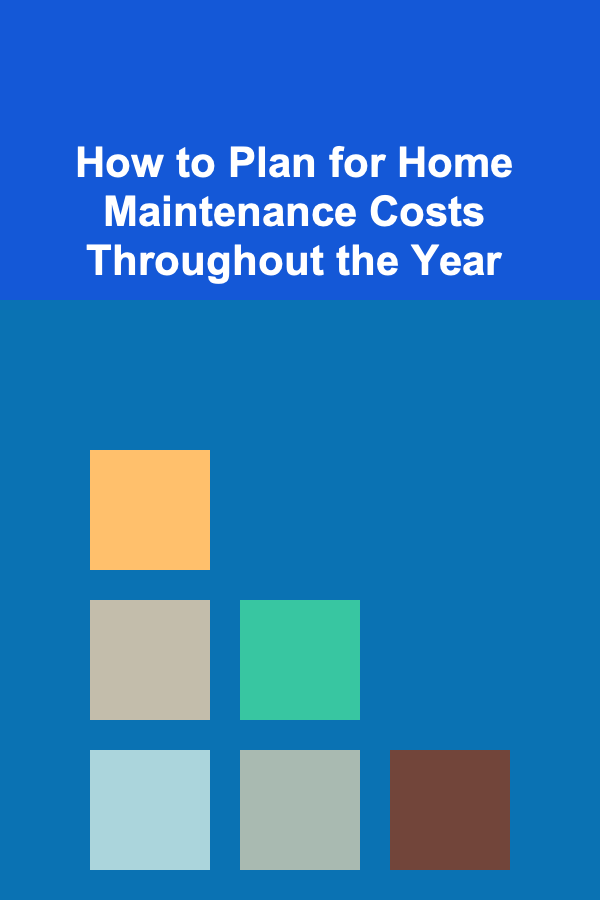
How to Plan for Home Maintenance Costs Throughout the Year
ebook include PDF & Audio bundle (Micro Guide)
$12.99$8.99
Limited Time Offer! Order within the next:

Owning a home is an exciting and rewarding experience, but it also comes with a considerable amount of responsibility. One of the most important aspects of homeownership is maintaining your property, ensuring that it remains safe, functional, and comfortable. However, home maintenance is often an overlooked and underestimated expense, and many homeowners fail to plan adequately for the costs associated with it. This lack of planning can result in unexpected financial burdens and stress when repairs or replacements are needed.
The key to avoiding these unexpected costs is proper planning. By understanding the various types of maintenance that your home requires and budgeting accordingly, you can minimize surprises and spread out expenses over time. In this article, we'll explore effective strategies for planning for home maintenance costs throughout the year, breaking down the different categories of maintenance, how to prioritize tasks, and ways to manage your home maintenance budget effectively.
Understanding Home Maintenance Costs
Home maintenance is a broad category that covers everything from routine upkeep to major repairs. It involves both preventive maintenance---activities that help prevent issues before they arise---and corrective maintenance, which addresses problems once they occur. Some maintenance tasks are seasonal, while others are required year-round.
The costs of home maintenance can vary depending on the size of your home, the age of your property, the climate in your region, and the materials and systems installed in your home. For example, older homes may require more frequent repairs, while homes in areas with harsh weather conditions may face specific issues related to the climate.
Understanding what types of maintenance costs you'll face throughout the year is the first step in planning your budget. Some of these costs will be predictable, while others might arise unexpectedly. Let's take a look at the main categories of home maintenance costs that homeowners should plan for:
1. Seasonal Maintenance
Seasonal maintenance refers to tasks that are specific to a particular time of year. For instance, preparing your home for winter, or ensuring it is ready for the hot summer months. These tasks usually occur once or twice a year, depending on the climate in your region.
- Spring: Spring cleaning, inspecting and repairing air conditioning units, checking for leaks around windows and doors, cleaning gutters, and ensuring the lawn irrigation system works properly.
- Summer: Servicing the air conditioning system, inspecting the roof for any damage caused by summer storms, cleaning out the attic and basement to prevent pests, maintaining exterior paint and siding, and servicing outdoor appliances like grills.
- Fall: Preparing the furnace and heating systems for colder months, inspecting and cleaning chimneys, sealing windows and doors to improve insulation, checking the roof for damage before winter weather arrives, and winterizing plumbing pipes.
- Winter: Shoveling snow from driveways and walkways, maintaining heating systems, checking for drafts, inspecting pipes to prevent freezing, and cleaning out dryer vents to prevent fires.
2. Preventive Maintenance
Preventive maintenance refers to routine tasks that help ensure your home operates efficiently and doesn't develop major issues down the road. These tasks generally need to be done regularly and may not be as exciting as major home renovations, but they play a vital role in preserving the value and safety of your home.
- HVAC systems: Regularly servicing the heating, ventilation, and air conditioning (HVAC) system is essential. Filters should be changed, coils cleaned, and refrigerants checked. An improperly maintained HVAC system can result in costly repairs and inefficient heating/cooling.
- Plumbing and electrical inspections: Periodic checks for leaks, clogged pipes, faulty wiring, and other issues can help avoid significant damage and prevent expensive emergency repairs.
- Roof and gutters: Cleaning and inspecting your roof and gutters every six months will help prevent leaks and water damage, both of which can cause costly repairs. Checking flashing, shingles, and ensuring proper drainage will keep your roof in good condition.
- Pest control: Regular pest inspections and treatments for termites, rodents, and other pests are essential for preventing infestations and costly damage to your home.
3. Major Repairs and Replacements
While regular maintenance can prevent minor issues from escalating into major problems, even the most well-maintained homes will eventually require significant repairs or replacements. These are often unpredictable, making it especially important to budget for them ahead of time.
- Roof replacement: Roofs typically last anywhere from 15 to 25 years, depending on the materials used. Over time, you may need to replace your roof, which is one of the most significant home expenses.
- Appliance replacements: Major appliances like refrigerators, washing machines, dryers, and water heaters have a finite lifespan. As they age, their performance declines, and eventually, they need to be replaced.
- Foundation repairs: Cracks in the foundation, water damage, or shifting soil can result in costly foundation repairs. These issues can be exacerbated by extreme weather conditions or poor drainage.
- Exterior siding and painting: Over time, exterior paint fades and siding becomes worn out. A new paint job or siding replacement can help maintain curb appeal and protect the structure of your home.
4. Emergencies
Unexpected emergencies can happen at any time. These are usually the most difficult expenses to plan for, as they arise suddenly and often require immediate attention. Examples include:
- Flooding or water damage: Water damage can be caused by broken pipes, heavy rain, or malfunctioning appliances like dishwashers and washing machines.
- Fire damage: Fires can occur due to electrical issues, gas leaks, or other factors. Repairing fire damage to both the structure and contents of the home can be expensive.
- Storm damage: Hail, high winds, or hurricanes can cause significant damage to your home's roof, windows, and siding, resulting in repair or replacement costs.
While it's impossible to predict exactly when an emergency will happen, having an emergency fund set aside for unexpected repairs can help reduce the financial burden.
Steps for Planning Home Maintenance Costs Throughout the Year
Now that we understand the different types of home maintenance costs, let's explore how to plan for them. Proper planning allows you to spread out your home maintenance expenses throughout the year, making it easier to manage your budget and avoid any surprises. Below are several strategies for planning home maintenance costs.
1. Establish a Home Maintenance Budget
One of the most effective ways to plan for home maintenance is by creating a dedicated budget. This budget should be separate from your regular living expenses and savings goals. Consider allocating 1% to 3% of your home's value per year toward maintenance costs. For example, if your home is worth $300,000, you should set aside $3,000 to $9,000 annually for maintenance.
Break this budget down into monthly amounts so that you're consistently setting money aside for maintenance throughout the year. This will allow you to avoid dipping into your savings or taking on debt when it's time for major repairs.
2. Create a Home Maintenance Calendar
A great way to stay on top of home maintenance tasks is to create a yearly maintenance calendar. This should include a detailed list of tasks for each season, along with the estimated cost for each task. For example, in spring, you might need to clean your gutters and service your HVAC system, while in fall, you might need to inspect your roof and prepare your furnace for winter.
By breaking tasks down seasonally and spreading out the costs over the year, you can avoid feeling overwhelmed by large, one-time expenses. You can also identify tasks that can be done less frequently (e.g., every two to five years) and budget for them in advance.
3. Set Aside an Emergency Fund for Unexpected Costs
In addition to your regular maintenance budget, it's essential to have an emergency fund specifically for unexpected home repairs. Homeowners should aim to set aside 1% to 2% of their home's value in an emergency fund. This fund can be used for sudden, unforeseen repairs such as plumbing failures, appliance breakdowns, or damage from natural disasters.
Having this fund readily available means you won't have to scramble to find the money when an emergency arises. Make sure to keep this fund in a separate savings account so that it's easily accessible when you need it.
4. Track and Review Maintenance Expenses Regularly
Tracking your maintenance expenses throughout the year is a crucial part of planning. By reviewing your expenses regularly, you can adjust your budget if necessary and identify areas where you may be overspending or underspending.
Consider using budgeting tools or apps that allow you to categorize and track home maintenance expenses. This can help you stay organized and ensure that you're putting aside enough money each month.
5. Prioritize Maintenance Tasks Based on Urgency
Not all home maintenance tasks are created equal. Some tasks---like inspecting the roof for damage---are critical to the safety and stability of your home, while others---like re-grouting the bathroom tile---may be less urgent.
When creating your maintenance calendar and budget, prioritize tasks based on urgency. Address critical tasks first, and save less important tasks for later. This will help you avoid putting off necessary repairs and prevent problems from worsening.
6. Get Multiple Quotes for Major Repairs
For larger, more expensive repairs or replacements, always get multiple quotes from contractors. This ensures that you are getting the best value for your money and helps you avoid overpaying for services. Be sure to hire licensed and insured professionals to ensure the quality and safety of the work being performed.
Conclusion
Planning for home maintenance costs throughout the year is essential for homeowners who want to keep their property in good condition without facing financial strain. By understanding the different types of maintenance costs, creating a realistic budget, and setting aside an emergency fund, you can ensure that you are prepared for the inevitable repairs and upkeep required to maintain your home.
A proactive approach to home maintenance not only saves you money in the long run but also helps preserve the value of your home, keeping it comfortable, safe, and functional for years to come. With careful planning, you can navigate the financial aspects of homeownership and enjoy the benefits of a well-maintained home without the stress of unexpected expenses.

How to Build Wealth with Real Estate Investments
Read More
How to Create a Family Calendar for Better Communication
Read More
How to Create a Home Security Checklist for New Homeowners
Read More
How to Keep Your House Smelling Fresh All Day Long
Read More
How to Maximize Cabinet Space with Adjustable Shelving
Read More
How to Use Technology to Streamline Volunteer Management
Read MoreOther Products

How to Build Wealth with Real Estate Investments
Read More
How to Create a Family Calendar for Better Communication
Read More
How to Create a Home Security Checklist for New Homeowners
Read More
How to Keep Your House Smelling Fresh All Day Long
Read More
How to Maximize Cabinet Space with Adjustable Shelving
Read More